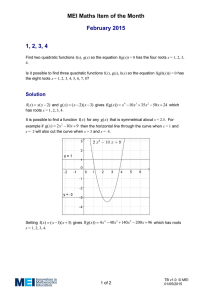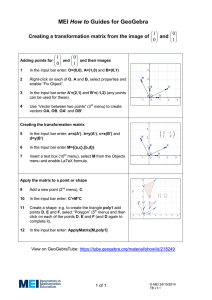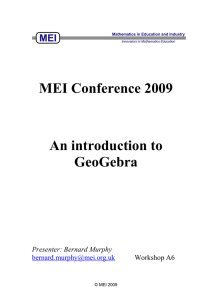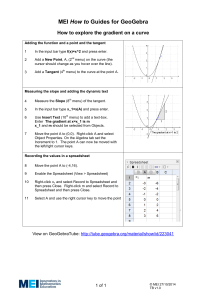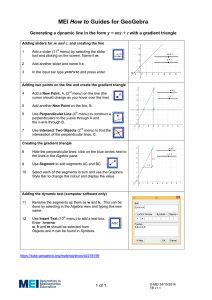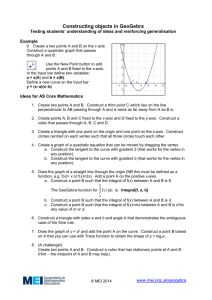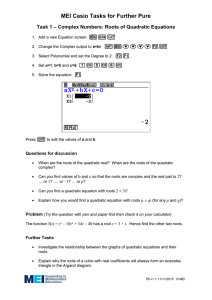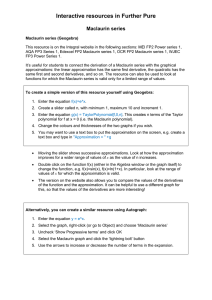MEI GeoGebra Tasks for Further Pure Complex Numbers x
advertisement
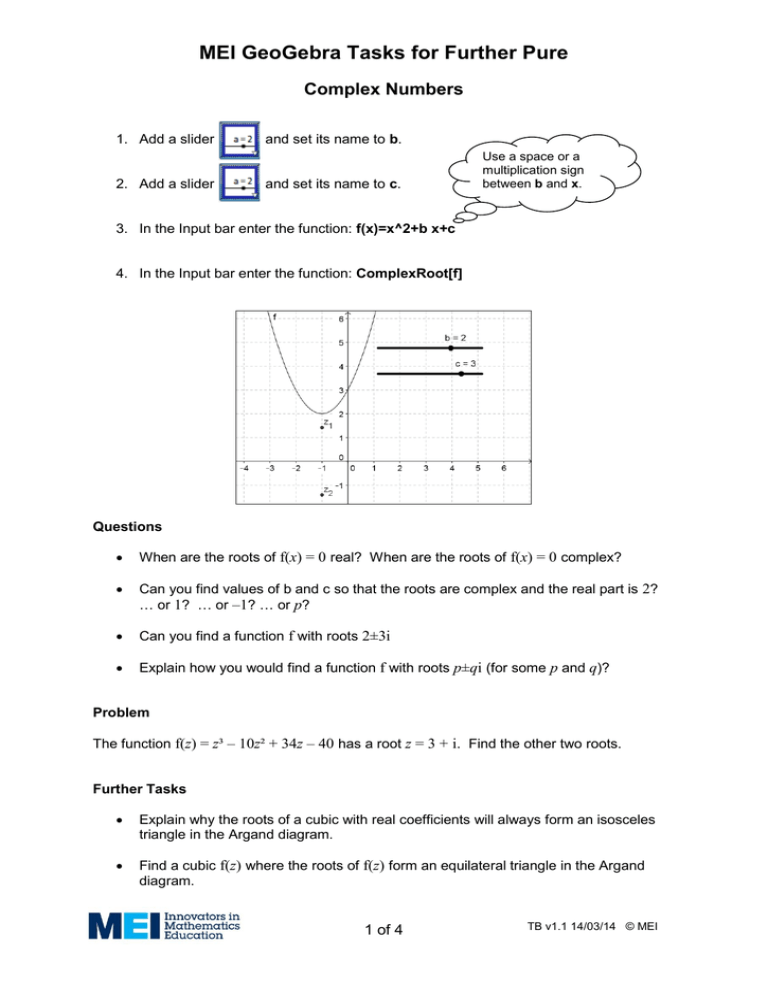
MEI GeoGebra Tasks for Further Pure
Complex Numbers
1. Add a slider
2. Add a slider
and set its name to b.
and set its name to c.
Use a space or a
multiplication sign
between b and x.
3. In the Input bar enter the function: f(x)=x^2+b x+c
4. In the Input bar enter the function: ComplexRoot[f]
Questions
When are the roots of f(x) = 0 real? When are the roots of f(x) = 0 complex?
Can you find values of b and c so that the roots are complex and the real part is 2?
… or 1? … or –1? … or p?
Can you find a function f with roots 2±3i
Explain how you would find a function f with roots p±qi (for some p and q)?
Problem
The function f(z) = z³ – 10z² + 34z – 40 has a root z = 3 + i. Find the other two roots.
Further Tasks
Explain why the roots of a cubic with real coefficients will always form an isosceles
triangle in the Argand diagram.
Find a cubic f(z) where the roots of f(z) form an equilateral triangle in the Argand
diagram.
1 of 4
TB v1.1 14/03/14 © MEI
MEI GeoGebra Tasks for Further Pure
Matrices
1. Use
to add 4 sliders a, b, c and d.
a c
2. Create the matrix M
by entering: M={{a,c},{b,d}} in the input bar.
b d
3. Use New Point (2nd menu)
to add a point, A.
4. Create the image of A under the transformation M by entering A’=M*A in the input
bar.
Answer the following questions for different matrices, M:
What is the relationship between A’ and A when A is on the x-axis?
What is the relationship between A’ and A when A is on the y-axis?
How can you use these relationships to find the position of A’ for any point A?
Problem
0 1
The image of the quadrilateral OABC under the transformation M
is a square.
2 0
O=(0,0), A=(2,4) and B=(4,0). Find the coordinates of C.
Further Tasks
4 2
Under the matrix M
the image of the point A=(–1,3) is A’=(2,4).
1 1
Find other matrices M and points A such that A’=(2,4).
3 4
A=(2,1) is an invariant point under the matrix M
because the image of the
2 3
point A=(2,1) is A’=(2,1). Find the invariant points of other matrices M.
2 of 4
TB v1.1 14/03/14 © MEI
MEI GeoGebra Tasks for Further Pure
Rational Functions
1. Use
to add 3 sliders a, b and c.
2. In the Input bar enter the function: f(x)=(x+a)/((x+b)(x+c)).
Questions
What point on the curve does the value of a give you?
What is the relationship between the shape of the curve and the values of b and c?
Problem
Find the values of a, b and c for the following curves:
Further Tasks
Can you find conditions on a, b and c so that the curve will have one of these general
shapes?
3 of 4
TB v1.1 14/03/14 © MEI
MEI GeoGebra Tasks for Further Pure
Parabolas, Hyperbolas and Ellipses
1. Use New Point (2nd menu)
to add a point on the y-axis, A.
2. In the Input bar enter: y=-y(A)
3. Use Parabola (7th menu)
to create a parabola with focus A and directrix
y=-y(A).
Question
What is the relationship between the equation of the curve and position of A?
Problem
Show that the line joining the points A:(4,4) and B:(–1, ¼) passes through the focus of
x² = 4y.
Show that the tangents to x² = 4y at the points A:(4,4) and B:(–1, ¼) meet at right-angles on
the directrix to the parabola.
Further Tasks
On the 7th menu there are tools for creating an Ellipse:
and a Hyperbola:
These are based the position of the two foci (A and B) and a point on the curve C.
Can you find positions for A, B and C for the following curves?
x2 y 2
1
9
5
x2 y 2
1
8 8
x2 y 2
1
25 34
1
y
x
4 of 4
x2
1
8
k
y
x
y2
TB v1.1 14/03/14 © MEI
